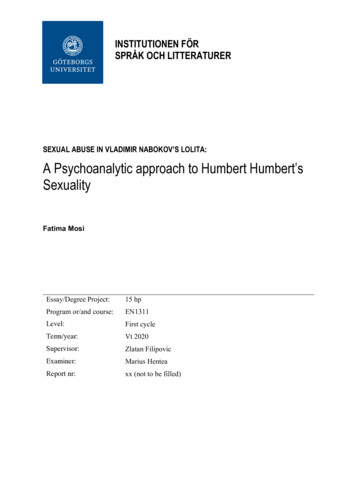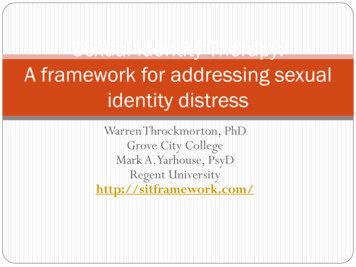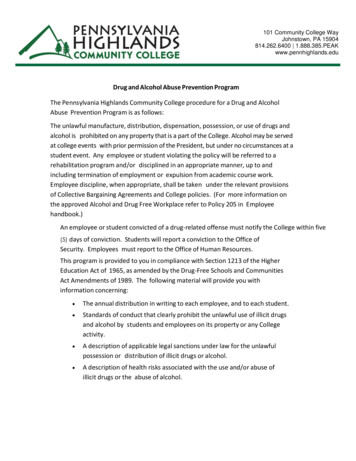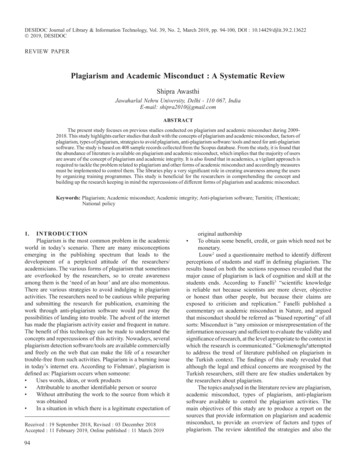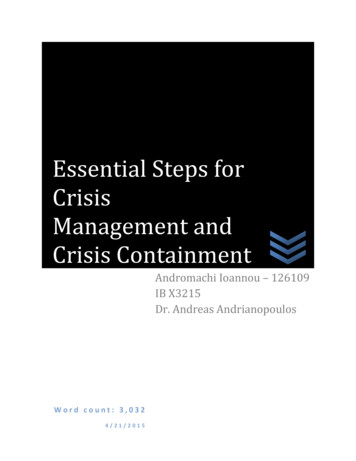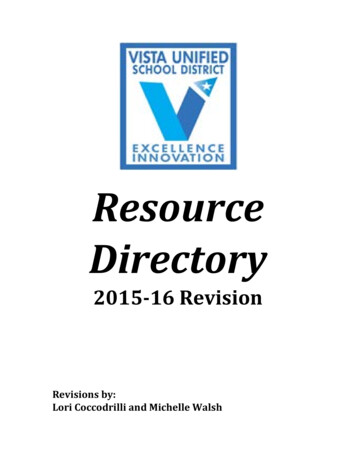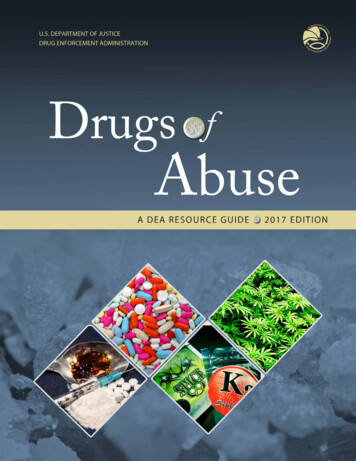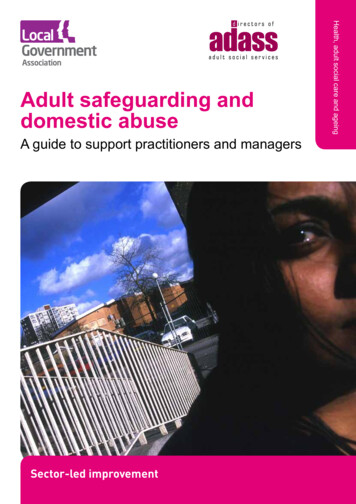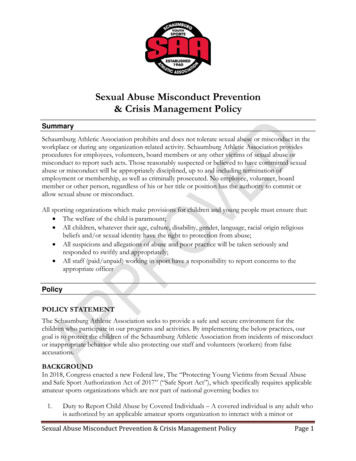
Transcription
Sexual Abuse Misconduct Prevention& Crisis Management PolicySummarySchaumburg Athletic Association prohibits and does not tolerate sexual abuse or misconduct in theworkplace or during any organization-related activity. Schaumburg Athletic Association providesprocedures for employees, volunteers, board members or any other victims of sexual abuse ormisconduct to report such acts. Those reasonably suspected or believed to have committed sexualabuse or misconduct will be appropriately disciplined, up to and including termination ofemployment or membership, as well as criminally prosecuted. No employee, volunteer, boardmember or other person, regardless of his or her title or position has the authority to commit orallow sexual abuse or misconduct.All sporting organizations which make provisions for children and young people must ensure that: The welfare of the child is paramount; All children, whatever their age, culture, disability, gender, language, racial origin religiousbeliefs and/or sexual identity have the right to protection from abuse; All suspicions and allegations of abuse and poor practice will be taken seriously andresponded to swiftly and appropriately; All staff (paid/unpaid) working in sport have a responsibility to report concerns to theappropriate officerPolicyPOLICY STATEMENTThe Schaumburg Athletic Association seeks to provide a safe and secure environment for thechildren who participate in our programs and activities. By implementing the below practices, ourgoal is to protect the children of the Schaumburg Athletic Association from incidents of misconductor inappropriate behavior while also protecting our staff and volunteers (workers) from falseaccusations.BACKGROUNDIn 2018, Congress enacted a new Federal law, The “Protecting Young Victims from Sexual Abuseand Safe Sport Authorization Act of 2017” (“Safe Sport Act”), which specifically requires applicableamateur sports organizations which are not part of national governing bodies to:1.Duty to Report Child Abuse by Covered Individuals – A covered individual is any adult whois authorized by an applicable amateur sports organization to interact with a minor orSexual Abuse Misconduct Prevention & Crisis Management PolicyPage 1
Sexual Abuse Misconduct Prevention & Crisis Management Policy2.3.4.PAGE 2 OF 21amateur athlete. Covered individuals must report suspicions of child abuse, including sexualabuse, within 24 hours to law enforcement. Failure to report may be a criminal violationunder state and federal law.Limit One-On-One Interaction with Minors – Must establish reasonable procedures to limitone-on-one interactions between an amateur athlete who is a minor and an adult (who is notthe minor’s legal guardian) at a facility under the jurisdiction of the applicable amateur sportsorganization without being in an observable and interruptible distance from another adult,except in emergency circumstances.Training for Adults and Minors – Must offer and provide consistent training to all adultmembers who are in regular contact with amateur athletes who are minors, and subject toparental consent, to members who are minors, regarding prevention and reporting of childabuse to allow a complainant to report easily an incident of child abuse to appropriatepersons.Prohibit Retaliation – Must prohibit retaliation against any individual who makes a reportrequired under the Safe Sport Act.An applicable amateur sports organization is one that is not part of a national sports governingbody, participates in interstate or international amateur athletic competition, and includes any adultwho is in regular contact with an amateur athlete who is a minor. However, even if a sportsorganization does not have a single team that crosses a state line to compete, the Safe Sport Actestablishes a new standard of care that will likely be used in future case law.Penalties For Failure To Comply: Any minor who was a victim and who suffers personalinjury as a result of a violation of the Safe Sport Act, may sue in U.S. District Court and mayrecover actual damages or liquidated damages in the amount of 150,000 and the cost of theaction, including reasonable attorney’s fees and other litigation costs. The court may alsoaward punitive damagesPURPOSEThe purpose of this risk management program is to reduce and/or prevent the occurrences ofmisconduct in sports as well as to reduce the liability potential for the sports organization.Misconduct can negatively affect participants, staff members, family, friends, and the sport.Specifically, our organization will implement policies in the following areas to address all types ofmisconduct and to set forth boundaries of appropriate and inappropriate conduct: sexualmisconduct, including child abuse; grooming behavior; physical misconduct; emotional misconduct;bullying; harassment; hazing; social media and electronic communications; locker rooms andchanging areas; travel; reporting misconduct; screening staff; and monitoring for compliance.This plan will serve as awareness education training for all our staff, members, volunteers, boardmembers and contractors who agree to educate themselves on all forms of misconduct and torefrain from engaging in such misconduct and in violating the policies herein. It should be postedon the organization website and distributed to all adult staff members.This plan is designed for the Schaumburg Athletic Association, which is considered a non-nationalgoverning body (Non-NGB) sports association. Organizations that are members of nationalgoverning bodies must comply with a higher standard of care and are subject to oversight from andreporting to the United States Center for SafeSport.
Sexual Abuse Misconduct Prevention & Crisis Management PolicyPAGE 3 OF 21DEFINITIONSThe following definitions or examples of sexual abuse, misconduct or harassment, may apply toany and/or all the following persons – employees, volunteers or other third-parties.Sexual abuse or misconduct may include, but is not limited to: Child sexual abuse – any sexual activity, involvement or attempt of sexual contact with aperson who is a minor (under 18 years old) where consent is not or cannot be given. Sexual activity with another who is legally incompetent or otherwise unable to giveconsent. Physical assaults or violence, such as rape, sexual battery, abuse, molestation or anyattempt to commit such acts. Unwanted and intentional physical conduct that is sexual in nature, such as touching,pinching, patting, brushing, massaging someone’s neck or shoulders and/or pullingagainst another’s body or clothes. Material such as pornographic or sexually explicit images, posters, calendars or objects. Unwelcome and inappropriate sexual activities, advances, comments, innuendoes,bullying, jokes, gestures, electronic communications or messages (e.g. email, text, socialmedia, voicemail), exploitation, exposure, leering, stalking or invasion of sexual privacy. A sexually hostile environment characterized as comments or conduct that unreasonablyinterferes with one’s work performance or ability to do the job or creates an intimidating,hostile or offensive environment. Direct or implied threats that submission to sexual advances will be a condition ofemployment or affiliation with the organization.Participant: Any athlete or non-athlete participant who participates in any tryouts, practices,drills, instructional sessions, competitions, camps, clinics, tournaments, or non-sport outingsincluding travel, lodging, and health or medical treatment sponsored by the organization.Child, Children, Minor, and Youth: Anyone under the age of 18. These terms are usedinterchangeably throughout this program.Coach: Any adult who has or shares the responsibility for instructing, teaching, schooling,training, or advising athletes of the organization.Misconduct: Behavior that results in harm, the potential for harm, or the imminent threat ofharm. Age is irrelevant to misconduct. There are six primary types of misconduct in sports:sexual (including grooming behavior), physical, emotional, bullying, harassment, and hazing.Organization: The sports organization that has adopted this misconduct risk managementprogram.Staff Member: Any paid or unpaid member providing service to the organization including butnot limited to officers, directors, administrators, coaches, assistant coaches, trainers, and teamparents
Sexual Abuse Misconduct Prevention & Crisis Management PolicyPAGE 4 OF 21RESPONSIBILITYAll SAA Executive Board members, sport board members, staff, and independent contractorsparticipating in any programs of the SAA.TYPES OF MISCONDUCT AND EXAMPLESThe following six types of misconduct are prohibited by the organization:1. Sexual Misconduct, including Child Sexual AbuseSexual misconduct is defined as: Any sexual interaction, whether non-touching or touching, that is forced or perpetratedin an exploitative, harassing, aggressive, or threatening manner. Any sexual interaction between a participant and an individual with direct, indirect, orevaluative authority. Such relationships usually involve power imbalance; disparity in age,development, size, or intellectual capabilities; the existence of an aggressor; and are likelyto impair judgment or be exploitative. Any conduct or acts defined under state or federal law as sexual abuse or misconduct.Sexual misconduct can be between adults, between adults and minors, or between minors.Minors don’t have the legal capacity to consent to sexual activity with an adult, and as a result,any sexual interaction between a minor and adult is strictly prohibited.Types of sexual misconduct include: Sexual assault Sexual harassment Sexual abuse Any other equal intimacies that exploit an athleteTouching offenses include: Fondling a participant’s breasts or buttocks; Providing a sports-related reward (ex: playing time, position, lessons, award, praise) inexchange for sexual favors; Sexual penetration and sexual touching; Genital contact whether or not either party is clothed Any intimacies or sexual relations between a staff member and participant when the staffmember is in a position of authority, trust, control, or evaluative decision making overthe participant.Permissible Physical ContactSome level of physical contact between a coach and a participant may be appropriate, such as ininstruction, celebration, or consolation of a distraught participant who has been injured or afterlosing a competition. Appropriate physical contact in training and instruction consists of thefollowing elements: The physical contact takes place in public.There is no potential for or actual, physical, or sexual intimacies during the physicalcontact.
Sexual Abuse Misconduct Prevention & Crisis Management Policy PAGE 5 OF 21The physical contact is for the benefit of the participant and not to meet an emotionalor other need of an adult.Physical contact should be appropriate for the development of a sport skillsPermission from the player/participant should be soughtPlayer/participants should be congratulated or comforted in public not in an isolatedsettingProhibited forms of physical contact include: Lingering or repeated embrace that goes beyond acceptable physical touch.Tickling, horseplay, or wrestling.Continued physical contact that makes a participant uncomfortable.Non-touching offenses include: Making innuendos, comments, or jokes of a sexual nature about a participant or otherbehavior that is sexually harassing.A staff member referencing his or her sexual activities with a participant.Questioning a participant about his or her sexual activities.A staff member requesting or sending a revealing or nude photo to a participant.Exposing participants to pornographic material.VoyeurismSending participants communications or photos, whether electronic (e.g. sexting) orotherwise, of a sexually suggestive or explicit nature.Intentionally exposing a participant to sexual acts.Intentionally exposing a participant to nudity (exception for shared changing areas orlocker rooms).Non-verbal or verbal communication of a sexual nature; physical advances; or sexualsolicitation.The following are not defenses under any circumstances to an allegation of sexual misconduct:the consent of a minor, mistaking the age of a participant, or that the interaction did not occurduring a sanctioned event of the organization.Peer-to-Peer Child Sexual MisconductApproximately one-third of all cases of sexual abuse are child peer-to-peer. Whether or notsexual interaction between children constitutes child sexual abuse turns on the existence of anaggressor, the age difference between the children, and/or whether there is an imbalance inpower and/or intellectual capabilities. Allegations or suspicions of peer-to-peer child sexualabuse must be reported to the child abuse officer or a board member.GroomingGrooming is an intentional and effective strategy that sexual predators use to set up and preparevictims, parents, and staff to gain a position of trust and lower their defenses, which assists inthe perpetration of misconduct.The steps taken in the grooming or seduction process are:
Sexual Abuse Misconduct Prevention & Crisis Management Policy PAGE 6 OF 21Identify a child and determine his or her vulnerable areas (ex: being misunderstood,lack of attention from parents, lack of spending money, absent parents, etc.)Through careful observation of the target, determine their needs to fill what ismissing.Fill the needs to create a special bond and to gain their trust. Examples are providinggifts and spending money, helping with homework, providing transportation, specialconsideration on the team such as more playing time, special attention, sharing secrets,etc.Spend a disproportionate amount of time with the family to gain their trust.Isolate the victim from their peers to create situations where they are alone.Gradually introduce sexual interplay that may start with conversations of a sexualnature (in person, texting, and social media), providing alcohol and drugs to lowerinhibitions, watching pornography, sharing nude photos, tickling, horseplay, massages,and other boundary invasions that lead to sexual touching and nudity.Maintaining control and silence to continue and keep the sexual abuse hidden.Use shame or fear as motivating factors to continue the relationship.Staff and parents who understand the grooming process and the policies that are meant toprevent it through education are likely to identify it and notify the MO or a board member ofsuspicious behavior.One-on-One InteractionsTwo-Deep Leadership: Two adults (ex: any combination of coach(es)), volunteer(s), parent(s))should be present at all times so that a minor cannot be isolated one on one with an unrelatedadult. This also helps to protect the staff member from false accusations.Individual Meetings: An individual meeting to address a participant’s concerns may be necessaryon occasion. During such meetings, the following guidelines should be observed: Any individual meeting should occur when others are present and where interactionscan be easily observed.Where possible, an individual meeting should take place in a publicly visible and openarea, such as in the corner of a building.If the meeting takes place in an office or a locker room, the door should remainunlocked and open.If a closed-door meeting is necessary, the staff member should inform another staffmember and ensure the door remains unlocked.Individual Training Sessions: When necessary or requested, parent/guardian writtenconsent should be obtained and a parent/guardian encouraged to attend.Prohibited One-on-One Interactions: Except as provided above with regard to individualmeetings, individual training, or emergency situations, any one-on-one interaction between anadult and a minor participant should be avoided. A possible exception may occur if the minor isstranded and the adult must be present so that the minor will not be left unattended orunsupervised. In such cases, the adult and minor should remain in the open until another adultarrives.
Sexual Abuse Misconduct Prevention & Crisis Management PolicyPAGE 7 OF 212. Physical MisconductPhysical misconduct includes: Intentional physical contact or threat of such that causes or has the potential to causepersonal injury or bodily harm to the participantAny act or conduct described as physical abuse under state or federal law, such asassault, child neglect, and child abuseExamples of prohibited physical misconduct:Contact offenses Punching, beating, biting, striking, choking, or slapping an athleteIntentionally hitting an athlete with objects or sporting equipmentProviding alcohol to a participant who is under the legal drinking ageProviding non-prescription or illegal drugs to any participantEncouraging or permitting an athlete to return to play after an injury (e.g. concussion)or sickness prematurely or without clearance from a medical professionalPrescribing diet or other weight control methods for humiliation purposes and withoutregard for the health of the athlete (e.g. public weigh-ins or caliper tests)Non-contact offenses Isolating an athlete in a confined space (e.g. locking an athlete in a confined space)Forcing an athlete to assume a painful stance or position for no athletic purpose (e.g.requiring the athlete to kneel on a hard surface)Withholding, recommending against or denying adequate hydration, nutrition, medicalattention, or sleepPhysical misconduct does not include physical contact that is a professionally-accepted coachingmethod for teaching skill enhancement, physical conditioning, team building or appropriatediscipline.3. Emotional MisconductEmotional misconduct involves a pattern of intentional, noncontact behavior that causes or hasthe potential to cause psychological or emotional harm to a participant. Physical acts, verbalacts, or acts that deny support or attention are included in these behaviors.Examples of prohibited emotional misconduct: Verbal Acts: A pattern of verbal behaviors that personally attack a participant (e.g.calling them disgusting, worthless, or fat) or repeatedly screaming at participants in away that does not serve a legitimate motivational or training purposePhysical Acts: A pattern of physically aggressive behaviors, such as throwing orpunching sports equipment or other objects in the presence of participants.
Sexual Abuse Misconduct Prevention & Crisis Management Policy PAGE 8 OF 21Acts that Deny Support or Attention: A pattern of ignoring or excluding a participantduring practice or team discussions for an extended period of timeEmotional misconduct does not include generally-accepted and age-appropriate coachingmethods of skill enhancement, physical conditioning, motivation, team building, appropriatediscipline or improving athletic performance. Note that a single incident such as a verbaloutburst may be inappropriate but does not constitute emotional misconduct, which requires apattern of harmful behaviors over time.4. BullyingBullying involves an intentional and repeated pattern of committing or intentionally allowing ornot preventing behaviors that are intended to cause physical harm, fear or humiliation in aneffort to socially isolate, diminish or exclude another participant physically, emotionally, orsexually.Bullying can occur through verbal, written or electronic communications or by means of aphysical gesture or act.Examples of prohibited bullying behavior:Physical: Hitting, pushing, punching, beating, biting, striking, kicking, choking, spitting, orslapping; throwing objects such as sports equipment at another participant.Verbal: Teasing, ridiculing, taunting, name-calling, or intimidating, or threatening to causesomeone harm.Social, including Cyberbullying: Using electronic communication, social media or similar toharass, frighten, intimidate, or humiliate someone; using rumors or false statements aboutsomeone to d
Sexual Abuse Misconduct Prevention & Crisis Management Policy PAGE 2 OF 21. amateur athlete. Covered individuals must report suspicions of child abuse, including sexual abuse, within 24 hours to law enforcement. Failure to report ma
